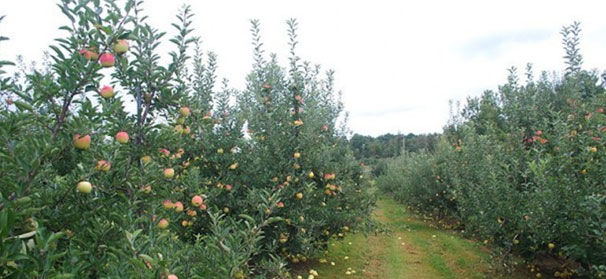

Dec 17, 2012Sandy causes market closures, wind damage
Hurricane Sandy, the largest Atlantic hurricane on record, was a tough blow to growers who already had to deal with a rough spring.
Sandy was the second-costliest Atlantic hurricane in history, only surpassed by Katrina in 2005, according to The Weather Channel.
In the United States, Hurricane Sandy affected at least 24 states, from Florida to Maine and as far west as Wisconsin. Taking the brunt of the storm was the northern half of New Jersey and southern portions of New York. Damage was especially bad in New York City and along the Jersey Shore.
As if the hurricane wasn’t bad enough, it was followed by a Nor’easter, named for the winds that blow in from the northeast and drive the storm up the East Coast along the Gulf Stream. That storm hit the same area with more rain, high winds and much colder temperatures, which brought snow and ice.
Effects
Sandy damaged more than just the United States as it moved up from the south. Crop losses in the Caribbean were heavy, with Cuba losing most of its coffee crop and Haiti losing 70 percent of all crops, said Milt McGiffen, a vegetable crop specialist with the University of California, Riverside. Crop losses in the United States appear to have been minor, largely because most of the crops on the East Coast were already harvested, he said.
The storm’s effects decreased greatly as it moved inland, McGiffen said.
“My contacts in Reading and central Pennsylvania did not see much, other than some rain,” he said.
Win Cowgill, a professor and Extension educator with Rutgers University, said that most fruit trees in New Jersey were not damaged too severely.
“Most trellises have held up well,” he said. “I have not had major reports of orchard damage. Infrastructure is another matter. Many deer fences have been crushed; roof damage and hoop house damage is extensive.”
Growers were probably affected most by the road closures and power losses, said Jerome Frecon, a Rutgers Extension educator. One grower he spoke to decided to close her business early this season, because of the difficulty customers had reaching her market.
The biggest economic loss has been the closing of markets, Cowgill said. New Jersey’s direct-market growers rely on tailgate markets in the fall for income, participating in two to 20 markets per week in New Jersey, and also in New York City’s Greenmarket system. Many of those markets were canceled for weeks after the storm, leading to a tremendous loss of revenue for some growers, Cowgill said.
Many farmers had generators to keep produce cold, but gas was in short supply and lines were long, Frecon said. A grower, who sells in New York City, told Frecon it was very difficult to get into the city. Many days, the markets were closed because of no electricity.
Kevin Grove, from the Quarter Branch Farm in Lovettsville, Va., said the storm demolished one of his high tunnels.
It will be a lot of work to rebuild the tunnel before winter, he said. There was extensive damage when the ground post on the windward corner broke, allowing the wind to lift the tunnel. The wind also pulled two 24-inch earth anchors out and broke the connector on another.
“I had a nice crop of tomatoes string-trellised to the ceiling,” Grove said. “They were all uprooted. I also had inter-planted lettuce. Some of it may survive, but it was disturbed. I have an adjacent plot of winter crops that I had planned to cover with this tunnel in a few weeks. I hope I can rebuild it in time to cover them before the real cold weather arrives.”
An FDA report stated that fruits and vegetables inundated by floodwater cannot be properly cleaned and should be destroyed. Fresh fruits and vegetables that have begun to spoil due to lack of refrigeration should also be destroyed.
Even if the crop is not completely submerged, there may still be contamination. There is also the potential for plants to take up contaminants. Mold and toxins may develop as a result of exposure to flood water, according to FDA.
The massive amount of water is cause for serious concern, said Ann Kopecky, a representative from Alltech, a health and nutrition company based in South Dakota.
“These environmental factors are precursors for fusarium mold growth on crops that are still in the field or stored where weather can affect them,” she said. “Many of the crops in this region have been harvested, but not all.”
What to do?
According to USDA, producers with damaged farms should contact their local Farm Service Agency (FSA) office. The Emergency Conservation Program (ECP) might be able to assist growers with repairs or debris removal. FSA has $15.5 million available for producers in counties that received a major disaster declaration. Growers not located in counties that have been declared major disasters should visit a local FSA office for information on ECP, if funding becomes available.
USDA’s Risk Management Agency said growers with questions on planting, replanting or crop losses should contact their crop insurance agent for information. Growers needing emergency credit may receive assistance through the Emergency Loan Program. Growers are eligible for these loans as soon as their county is declared a disaster area.
Growers with federal crop insurance, or looking for help under the Noninsured Disaster Assistance Program, are covered when floodwaters have rendered their crops valueless. USDA is urging growers to contact crop insurance companies to report damage to crops and trees. More information about federal crop insurance can be found at www.rma.usda.gov. Additional resources to help farmers and ranchers deal with flooding and other damage can be found at www.usda.gov/disaster














